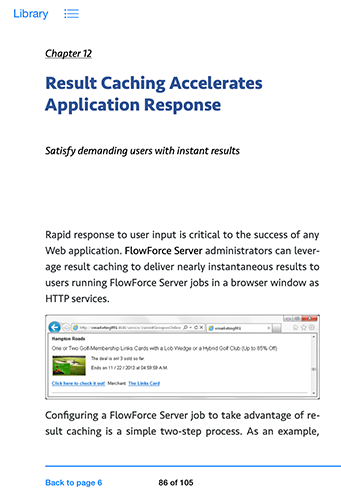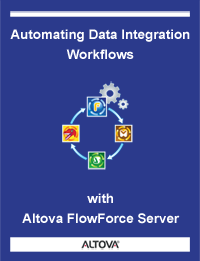Automating Data Integration Workflows – Download the E-Book
We’ve published an e-book titled Automating Data Integration Workflows with Altova FlowForce Server that is now available for free download from the Altova Web site.
Here is a brief description: FlowForce Server is a highly-customizable platform to automate data transformations defined by MapForce data mappings, report and document generation, and other tasks on dedicated servers, virtual machines, or workstations scaled for the scope of the project. FlowForce Server empowers data architects, analysts, and other IT professionals to efficiently complete enterprise-level data integration tasks.
Automating Data Integration Workflows with Altova FlowForce Server provides an overview of the Altova FlowForce Server platform through a series of real-world data integration tasks and examples.
The new e-book collects updated information from the Altova Blog, the Altova Web site, and some all-new material, organized in one location to help new FlowForce Server users get started and to suggest new applications and efficiencies for experienced users.
The e-book also describes MapForce Server, StyleVision Server, and RaptorXML+XBRL Server, and how they are managed in a FlowForce Server configuration.

You can download a free copy of Automating Data Integration Workflows with Altova FlowForce Server from the Altova Web site in various formats by clicking any of the links below:
Or, look for Automating Data Integration Workflows with Altova FlowForce Server soon in your favorite online electronic bookstore.
Comparison of E-book File Formats
All four files listed above contain the same text and illustrations, but are formatted differently. Here is a description of the features, advantages, and disadvantages of each format:
EPUB is a free and open e-book format. Text is stored in .HTML files and images can be in a variety of native image formats. All files in the document are combined into a ZIP-compressed archive, so the overall file size is small.
EPUB files are designed to be displayed dynamically and flow to fit the size and orientation of the screen of the reading device, so an EPUB document has no fixed page count.
Altova XMLSpy can open, edit, preview, and validate EPUB documents. EPUB files can also be read in the iBooks application on iOS devices, and in any number of free EPUB e-reader applications for Android or Windows 8.
The Kindle version listed above uses the file extension .mobi, which designates a format originally developed for the Mobipocket reader, based on XHTML that can include JavaScript and frames. As you can see from the list above, the Kindle version is also relatively small. Kindle readers and Kindle applications on other devices such as Android tablets and iPads can only read .mobi files or the closely-related Amazon AZW format. Like the EPUB format, text and images of Kindle files flow to fit the screen and orientation of the reading device. Files in the .mobi format are generally not editable after they are created.
PDF stands for Portable Document Format, a format invented by Adobe for the Acrobat platform. PDF was first released in 1993 as a means of exchanging documents including text, complex layouts, and images between users who may not have compatible application software. The PDF format provides a document viewing experience that can be described as near-photographic, in that documents are intended to look the same on all platforms. PDF may not be the best format for e-reading on tablets and other mobile devices, since text does not automatically reflow to match the device characteristics, and the user cannot apply font and size preferences. The PDF file listed above is exactly 89 pages long on all devices. Small edits can be made to PDF files using Adobe Acrobat Pro, but reflowing text as might be required for a complex revision is difficult or impossible. PDF file sizes can vary based on typeface embedding and image compression.
The iBooks format can be read on an Apple iPad or iPad Mini using the iBooks app, and on Macintosh computers. The iBooks format file listed above was created using a standard document template in the iBooks Author application, currently available for Macintosh as a free download from Apple. The file format is reportedly based on EPUB, with extensions for multimedia and interactive elements. Documents created in iBooks can be designed with a different viewing experience, and even different content, in portrait and landscape modes.

So which format is best? That depends on nothing more than your personal preference and which device you use to read your own favorite e-books.
Get started for yourself with Altova FlowForce Server – click here to download a free trial!

